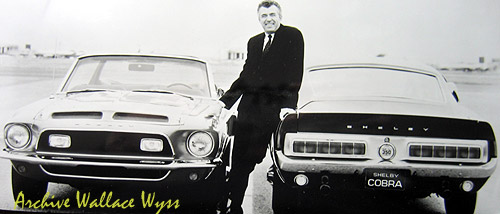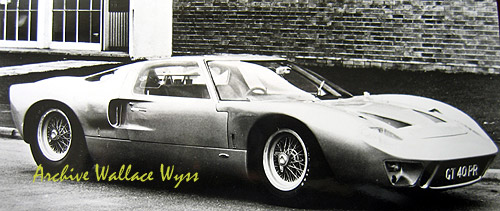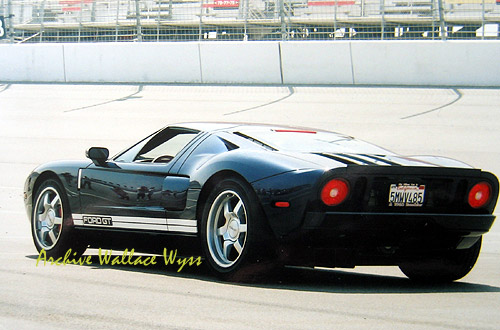Here I present the Wallace Wyss interview regarding one of his newer books: SHELBY. The Man. The Cars. The Legend. If interested in the book please let me know, I have a few autographed copies I wouldn't mind parting with (if the price is right :) and I may even be able to get a personal autograph for you.
Format: Softbound, vertical, 208 pages, published by Iconografix Inc. in 2007
Q: Tell us about your biography of Carroll Shelby entitled SHELBY: The Man. The Cars. The Legend. Is it a race-by-race history?
A: No, the Cobras' racing history, both roadsters and coupes, is covered in brief, and the GT40 program as well but it's all kept general, because there are plenty of coffee table-like books that go into each car's serial number-wise and recount what happened to each car at each race. In this book I focused on the big picture--why Ford sponsored Shelby, why Ford caved in and gave a failed chicken farmer $25,000 to get the ball rolling on the Cobra, or why Ford thought winning at LeMans was so crucial, etc.
Q: So by "big picture" you mean no nuts-and-bolts?
WW: Oh, there's nuts and bolts but I figure that with the advent of the internet, you don't need to go into what the cfm was of the '65 Shelby GT-350 carburetor because anyone who wants to know a technical fact like that can now go to a search engine and find that in five seconds. I spent my time trying to find out why Ford did this or Olds did that in respect to Shelby, which gives the reader a broader view than just discussing the hardware.
Q: What made you think of this approach?
WW: Well, there’s this author I know from Detroit, where I grew up, Eric Davison,. I worked with Eric in Detroit on the Oldsmobile ad account more than forty years ago. Much later on, he moved to Los Angeles and I worked as a copywriter for the agency he was with out here. After his retirement, when he told me he was working on his book "Snake Bit," discussing the Shelby Series 1 project which he had been involved with. I kept asking him "Why don't you broaden it out to cover all of Shelby's business history?" but he replied "I worked on the Series 1 and that's what I know" so he stuck to that and came out with a damn fine book that really nails it--the whole saga of how a car with so much promise ended up being so compromised. But that episode is only a fraction of Shelby’s entire business history so one day I figured "If Eric didn't do the general business history, I'll go ahead and do it myself."
Q: Did you have any other inspiration?
WW: Well, it's hard to believe but a picture of Ralph Lauren in his 1957 Ferrari Testa Rossa was another inspiration. That's because ol' Ralph, who everyone knows as the founder of Polo brand clothes, was pictured toodling along in his $5 million Ferrari wearing a leather jacket, like an old flying jacket, and a billed baseball cap and I thought "That's cool--tooling around in a car so fast and powerful and valuable but dressed like he's going out to walk his dog. I know Cobra people who look like that--driving powerful Cobras but dressed casually, unlike Ferrari owners who are always trying to impress you with their clothes and expensive watches and so forth. So I partly did the Cobra book to try to capture that spirit in print of the Cobra owners and took pains to spend a few paragraphs trying to describe the feeling that comes from driving around in a Cobra. It's a world-conquering feeling, especially when you put the pedal to the metal.
Q. What about the style of the writing?
WW: Well, some would say it's not laudatory like some car books where the authors just worship the cars they are writing about. In fact you could say it's a bit gossipy--telling tales that couldn't be told at the time, for instance, why Ford wanted to get rid of Shelby in 1969, mainly because they had the Boss Mustang and didn't need the Shelby Mustangs anymore. Or why Shelby pulled out of Indy with his gas turbine cars at the last minute. The tone and style were inspired by Brock Yates who wrote a book on Harley Davidson called Outlaw Machine: Harley Davidson and the Search for the American Soul in which he told more of why men lust after Harleys rather than compare the engine designs of the shovelhead vs. the panhead, etc. For instance, there's that incident in the early 50s when some bikers tore up the town of Hollister, CA. That gave bikers an image which still says "bad boy" today--60 years later! And Yates also wrote a book entitled Ferrari The Man the Cars The Races which Ferrari people have tough time digesting because it really shows the vain side of the man, and his ruthlessness. I didn't go that far but let's just say that I expect my book will be a good counter to the upcoming book by Rinsey Mills called SHELBY: The Authorized Biography (MBI 2012) which I presume will be all glorification of what Shelby hath wrought.
Q. What about other books already on the market?
WW: There are many new books on Cobra and Shelby but back in 2007 none of them discussed Shelby's driving career. One was eventually written by Art Evans and I'll do a review of that. But when I got it in 2010 I saw that I was right to assume back in 2007 that if Evans did a book it wouldn't segue from Shelby's driving career into his business life like my book does. I like to feel that Shelby's hard charging style as a race driver is reflected in his hard charging style as a businessman, so it was a natural approach to me to take a couple of chapters to educate the newcomers to the fact that Shelby was one of America's most promising sports car drivers in his early career--at a time when sports car driving was still damn dangerous. You could get killed in an instant. In fact when Shelby was first racing they didn't even use seat belts! What makes Shelby interesting as a subject is the fact that he came out of nowhere--a country bumpkin compared to the more sophisticated guys like Phil Hill and Masten Gregory who could plunk down the cash to buy their own Ferrari. When Shelby first began racing, Phil Hill was already a professional driver while Shelby was still a chicken farmer. The fact Shelby came out of nowhere and won LeMans only five years after he first began making money as a driver is really worth talking about.
Q: Did you talk to many Shelby employees?
WW: Off and on. In fact, you could say this is a story I've been working continuously for forty years, ever since a pert young lady named Pat Merone pulled up next to me by chance in a 427 Cobra back in '66 or so and asked directions to Cobo Hall in Detroit. I told her "I'll show you the way if you give me a ride." She said "Yes" and I jumped in , belted myself in and she took off screeching rubber at 140 mph! So, in the intervening 40 years I've talked to many former employees, starting with Shelby at Cobo Hall back in the Sixties but, while researching this one, I went back to visit a selected few, including Phil Remington who still works at Dan Gurney’s shop though he's in his 80s. Also forty years ago when I researched the first book, Al Gore hadn't yet invented the internet so I couldn't reach people I was trying to find. Now in a few minutes, I can contact former race car designers and racers throughout the world to clarify different small points like why the suspension was unsatisfactory on the Len Terry-designed King Cobra.
Q. With so much to cover, how much content is there on the Mustang?
A. Quite a bit, I have a chapter on the Shelbys. In that chapter I go into how Shelby was asked by Iacocca to build the Shelby Mustang and it is interesting to me how reluctant he was at first.and then later on I have another whole chapter on Trans-Am racing. Then of course, the last chapter talks about Shelby's re-hiring as a spear carrier by Ford to sell the '07 Shelby Mustang and there's still Shelby Mustangs being made now, in 2011.

Carroll Shelby with two of his 1968 cars, a promo photo..
Q. Did you learn anything in your research you didn't know before?
A. I always learn! I didn't realize until I read Dave Friedman's book on Remembering the Shelby Years how much Holman & Moody, the stock car race car builders, were always trying to rip off a piece of Shelby's business, and I think if Shelby hadn't accepted the assignment to do the Shelby Mustang the hot Mustang would have been a Holman & Moody Mustang instead. They had the experience over Shelby in building short runs of cars (having built the Ford Thunderbolt drag racing cars in '64). Also I think few Americans are aware that the first Mustangs ever built were sent to Alan Mann for preparation as rally cars so the Mustangs were already racing when Americans were being sold the car as a "secretary's special." And the Mustangs were already racing in Europe before Shelby ever saw one!
Q: And do you go into Shelby's later business ventures?
A: Yes, this book goes well beyond Shelby-American. It recounts Shelby's Tiger involvement, his working with Iacocca on the front wheel drive Dodges and the Viper, then the Olds-powered Series 1, and ends with the new deal with Ford.

From the 1966 Ford GT40 ..... (pictured here one of Fords road cars. Ford made 50 identidcal ones for FIA homologation)

..to the 2005 Ford GT. Both were built to fire up the disspirited troops at Ford. It did create a classic that will not be beat by another American production car for decades to come.
Q: But weren’t you really taking a chance on losing the 100% Ford fans by covering non-Ford related Shelbys?
WW: Not really, it’s pretty clear by the subtitle that this particular book is about Shelby the entrepreneur , and not confined to just his association with Ford-powered products. I follow him in his journey from one automaker to another, for better or for worse. The subtitle is "The Man, the Cars, the Legend."
Q.: How do you come down on the Cobra replicas?
WW: I have a whole chapter on that non-stop knock-down drag-out battle that has continued for something like 30 years between Shelby and the clonesters copying his cars. I tell how initially Shelby was opposed to all replicas of his cars but then recount how it was that he gradually came around to entering the replica field himself. In fact, his Cobra replicas are among the highest priced ones on the market.
Q: What about artwork?
WW: There is artwork in the form of black and white photos This is primarily a words book, as opposed to what I call a “coffee table” tome like Randy Leffingwell's beautiful (and heavy) book , also entitled “Shelby”(published by MBI) or Colin Comer's book The Complete Book of Shelby Automobiles both of which I would characterize as primarily a “pictures-with-words” books.Both are great in terms of lusterous pictures of the cars in their best condition (many restored ones). I could have done that but I wanted a low cost book that anyone--even a beginning enthusiast--can afford. So I downplayed the pictures, even having them put all in one section like the low cost car books used to be back when I was growing up. My book has 76,000 words and a mere 16 pages of pictures.
Q. Are there many historical pictures?
WW: A few. Many from the press kit. I had a PR photographer question my right to use the press pictures but I went to Ford PR and while I was in the PR office volunteered to call the editor who was with me in 1965 when I went to the Shelby factory on assignment from Motor Trend magazine and they handed me the press kit. I told the PR man in 2007: "When Shelby's PR man Don Rabbitt handed this to me over 30 years ago , he never put any restrictions on when and how I could use them." We never had to make that call though my editor at the time was waiting for it. I have been in auto writing for 40 years and have run across any other photographer who was paid by an automaker to take publicity pictures come back decades later and want payment for the prictures that the automaker handed out willy-nilly back in the day.
Most of the pictures I took myself at various events over the last 40 years even as late as 2007.
Q: Who do you see as your market?
WW: Well, my thought back in 2007 was that, with over 10,000 people scheduled to buy the new GT500 Shelby Mustang and who knows how many buying the '07 Shelby GT Mustang and even those buying the GT/CS Mustang, there's going to be a whole lot of newbies entering the Shelby world in 2007 and not all of them have been involved in the marque for 40 years like myself, so many will be clueless about such terms as "FIA cars" or "USRRC cars" or "cut-back fenders." At the beginning stages of a newcomer’s interest in the man and his cars, I figured they want to know basics, like "Why did Shelby become involved with Dodge?” and so forth.
With the newcomer to the marque in view, we kept the cost down by going softbound and pricing it at $19.95, so it’s the ideal bargain book for Shelby fans to give to their buddies to get them up to speed on Shelby so they can later dive into the subject deeper and buy the single marquee books that list all those nitty gritty details of each Shelby model. In other words, while it's interesting to note the differences between the FIA and USRRC small block Cobras, I wanted to tell them first why Ford thought it important Shelby race in FIA and USRRC competition with the cars.
Q: Did you have any help from Shelby or Ford?
WW: Of course many authors doing a book on this marque or that one go straight to the subject’s PR firm and say “What can you give me?” and I did that at first but stopped asking when it looked like they expected me to submit the work for approval. But I didn’t want to have a PR man looking over my shoulder and saying ‘Oh,for God's sake, don’t put that in,’ because it’s my feeling is that no real historian would go for that. If he does, he might as well be a PR man. I enjoy an ongoing relationship with Ford PR but they never saw more than a handful of pages and those only on the ’07 Shelby models. They did loan me a Ford GT to drive and that was useful in understanding that car. I had to sneak in the Ford GT preview, but that's an amusing story in itself I'll tell in a separate story.
Q. We heard Hollywood has an interest in your book?
WW: Hollywood or London. the two producers that announced 1-26-11 that they are going to base a miniseries on the book
are based in both places. They are a coupla brothers who have been making action movies for several decades, and I was pleased when I saw the list of the films they have made that I have seen almost every one of them from Gladiator to Top Gun.
Q. Will it be about Shelby per se?
WW: I don't know. When producers glom onto a literary work, they sometimes just use it for inspiration and go off on their own direction. In the advance publicity they seem to be angling in on more of a Americans-taking-on-the-
Q.Will there be another edition?
WW: I don't know. I am not the publisher. Every book has its time in the sun. My original, Shelby's Wildlife: the Cobras and the Mustangs, was in print for 17 years. But that's the good thing about SHELBY The Man The Cars The Legend being a low cost book--if I have to assume the mantle of publisher, it will be a relatively low cost book to reprint. I think that with all the newer books on Shelby being so expensive, there will always be a place for a low cost book.

When I was a child, I had a model car. It was a Shelby Cobra.
ReplyDeleteNice car. Nice blog. Please feel free to message me offering your services in design for a blog.